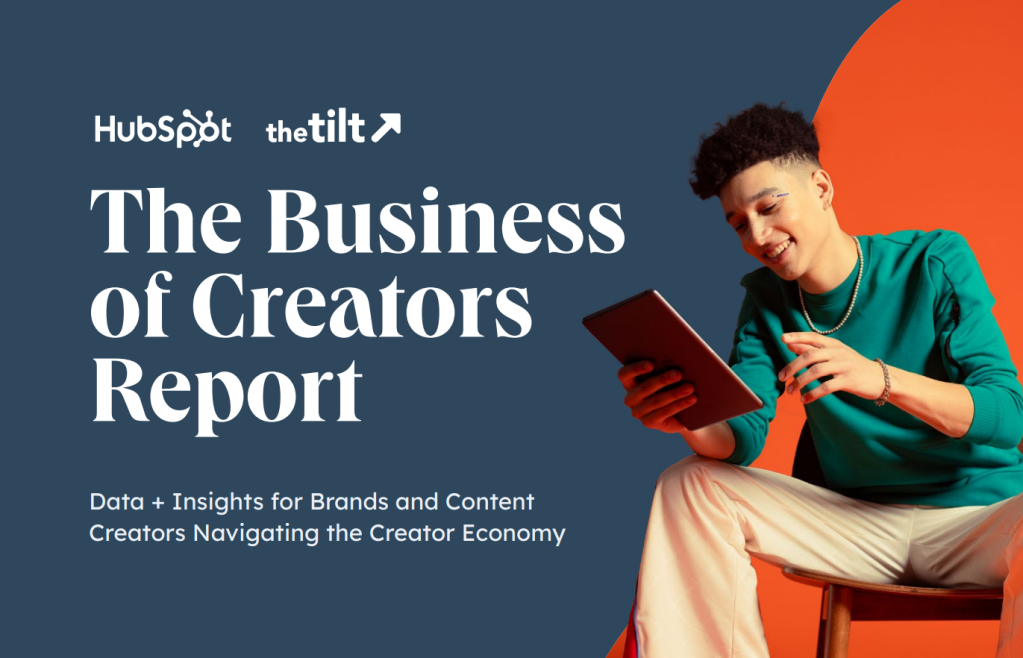Creators are dominating online and growing highly engaged, niche audiences. It makes sense — people listen to people they trust.
Now, more and more brands understand the value of community-led growth. Hubspot’s 2022 State of Inbound Marketing Trends Report found that 88% of brands have a dedicated budget for working with influencers and creators, and community is a top priority for marketing strategy in the year ahead.
We read it, and we’ll tell you what we think about it.
You have to put your messaging together so that it is working to bring in clients, to bring in audience members. That takes time and you’re not going to be making a lot of money while you’re working on your marketing and your message. Except if you bring in a client and you’re doing “done for you” work. But that is labor and time intensive. So although you’re making those first dollars, it isn’t consistent and you’re trading time for money.
Shelley Carney, Livestream Coach
This report was done in cooperation between HubSpot, which is a business that offers a Customer Relationship Management tool designed for marketing organizations, and The Tilt Newsletter which helps creators grow full-time, independent content businesses that don’t rely on social media platforms.

This report was constructed for the benefit of large brands that need some new social media creators.
It was designed for them to understand the content creator’s ecosphere so that they could decide how to work with these individuals in the promotion of their brand.
They wanted to give those brands a sense of the characteristics of that ecosphere in which content creators reside.
We consider ourselves content creators who make an income by creating content.
Brands aren’t our target market, so we thought we’d analyze this report and come up with findings, conclusions, and recommendations based on who is in our audience of content creators.
We have an audience in the second half of life. We take a lot of information from these resources and interpret that for the older generation of content creators.
Who Are Creators?

Content entrepreneurs are independent content creators who have built or are in the process of building their own businesses around the content they create and the skills associated with that content creation.
Content entrepreneurs are working towards engaging a community of like-minded individuals.
Those two elements of the successful content creator are important.
You’re creating content and you have identified a community of people who might be interested in that content.
84% of content creators don’t believe that higher education is necessary to be a successful creator.
That’s been proven. I know of at least a dozen content creators who do not have college degrees but are very successful at what they’re doing.
84% create content because they enjoy their work.
I get to do things I love doing and we get a response. That’s very satisfying, and it motivates me to get up every morning and start challenging myself to do different and better things each day.
What Generation Do Content Creators Belong To?
Millennials are at 35% and Gen X is at 41%, whereas Boomers are only 9%.
Toby is definitely in the boomer generation.
Shelley is on the older end of Gen X, which is in the majority at 41%.
Active Boomers can do it, but they’re less likely to be doing it.
Reasons for that may relate to the time and effort it takes to completely understand the technology that’s there to support them.
Are Creators Making Money?
77% of creators say they’re making money.
That’s nebulous when you think about it.

How are you making money?
It isn’t until you establish relationships with other people or establish yourself as something more than a content creator that you begin to bring income into your business.
A little over 25% of content creators are fully supporting themselves via content.
You start slow, for yourself, and then as you grow, you can decide whether it’s worth it to move into this as a full-time business.
You need to commit more hours and effort for it to become more than a hobby or a side gig.
If you have a business that is supported by your content, then that makes all the difference.
If you’re offering coaching or consulting to your audience, then you are making money, but maybe you’re not doing it consistently.
The trick is to find a way to bring in a consistent income, and that can take a couple of years as a content creator before you get to that level.
How Long Ago Did You Launch Your Creator Business?
The largest group, 35.9% percent, said one to three years.
I was surprised to see that 28%, almost 30% of the individuals have been doing it for seven or more years.
I don’t think people would stay with it for that long if they weren’t incentivized by making money. There’s no strong enough reason to stay with it if you’re not getting some kind of return on it.
How Long Does It Take to Get Profitable?
Profitability is difficult to measure because you’re not quite sure at what point you are being profitable.
You have to consider your capital investment in things like technology.

It takes an average of about six months for creators to start generating any kind of income from their effort.
That can come in a variety of ways, from using social media platforms to produce income based on views and advertising, all the way to speaking engagements.
It takes as long as it takes because you are honing your craft. You’re learning more about what you enjoy doing. You’re sorting through messaging and marketing.
Marketing is experimentation.
You have to put your messaging together so that it works to bring in clients and audience members.
That takes time and you’re not making a lot of money while you’re working on your marketing and your message.
Then you bring in a client and you’re doing “done for you” work.
That’s how we started.
We started with a client. We set up her studio. We helped her set up her YouTube channel, her podcast platform, and her blog. We got her started with all of that, and we coached her for six weeks. That was very hands-on for us, although we did most of it online.
It was labor-intensive for us and that’s how we brought in some money. But we couldn’t take on more than one or two clients like that at a time.
We also did production services for a client who would show up and we would produce his livestream for him and send it up to his podcast.
But those are labor and time-intensive pursuits. So although you’re making those first dollars, it isn’t consistent and you’re trading time for money.
Until you can get to a place where you have set up digital products that are evergreen, that people can purchase anytime, and you have a membership where you know people are showing up and paying for it every month, you probably won’t have a consistent income.
When you can turn your content creation business into a machine where you bring people into the funnel and money comes out at the end, then you know you can stay with it.
You have to treat content creation like a business. You may not have tangible goods, but you do have tangible services, especially if you’re coaching.
How Do You Succeed As a Content Creator?
The research indicates 64% of content creators consider it a full-time job.
We don’t do anything else to generate revenue. We don’t have any side gigs.

When we create a course or release a new video, those aren’t side gigs.
Those are an extension of what we do.
35% consider it a side gig or hobby.
Being a successful content creator requires a significant investment in time, resources, money, manpower, and equipment. You have to be willing to make that investment and you will not get it back right away.
Successful creators keep up with trends, publish timely, high-quality content, and regularly publish on multiple social media platforms.
Which Business Strategy is the Most Profitable?
The most profitable business strategy is consulting and coaching.
You have to know who is your audience.
What is their main problem?
How can you uniquely solve that problem?
What messaging can you put together to create an irresistible offer so that people purchase your offers?

That could be coaching or you could send out proposals to corporations or other brands that you could help.
Start by working as a consultant. That’s time for dollars, but it’s a great way to get started and it’s the best way to make the most amount of money.
If you are an expert, you’ve got years of experience, and you’re successful, then consider coaching others.
What Profits Can We Expect?
Almost 40% of content creators want to grow as a solopreneur and are not interested in hiring employees or contractors.
We like flexible hours. We don’t want to wait for other people to get things done. It’s important to us to get it done in a timely manner.
We want to build our own business in our own timeframe.
We’re the ones responsible for every failure and every success.
Another 7% want to continue content creation as a hobby rather than grow their business. They just want to do it as a side gig.
They like the full-time job that they have. Maybe they have a podcast or a newsletter, something that they enjoy doing, but it isn’t about the money. It’s about spreading their message and sharing their passion.
How Do You Spend Your Time As a Content Creator?
Almost 50% said they spend their time creating content.
It means you are not only creating content but learning how to create better content.
The next sizable amount of time spent is on distribution and promotion.
Marketing, business administration, and operations require your time because you are running a business.
If you can build a community around the content that you’re creating, you can grow faster.
Look at other channels that are doing something similar to what you’re doing, and then reach out to talk to them about how they’ve been successful.
How Much Does It Cost to Be a Content Entrepreneur?
Most creators report that they have to earn over $15,000 in annual revenue to meet their needs.
The costs involved in creating content include all the software that you’re using.
Paying for an accountant to help you with your taxes is another expense.
You don’t realize how much your expenses add up until you go to do your taxes or identify profits and losses for the year.

Creators tend to use their savings or disposable income from another job to pay for startup and operations costs.
More than 20% use credit cards or loans.
We fall into that category of people who have a disposable income that they can use.
This is what we do to keep active and pass the time in a productive and interesting way. This is healthy for me and my doctor agrees with that, so it doesn’t bother me to take a little of my disposable income and invest it in this business.
It surprised me to see the number of folks that use credit cards or loans. You need to have a plan in place to pay that off.
We check our expenses at least quarterly. We discuss our business expenses and possible swap overs together.
For instance, we’re working on building a new website.
We pay $20 a month for our current content website, Podpage. We found a $69 app from App Sumo, called SupaPass, that does the same thing. We can post all our content there under one link and it even gives us a paywall to charge for premium content, much like Patreon.
So, we’ll take that $20 a month that we were spending and get a new, more complete website that really works well for SEO and mobile access.
Don’t spend money on things that don’t benefit your business.
Why Do People Choose to Be a Creator?
What benefits are going to be most important to you?
Ask yourself this before you even get started.
One third of the people interviewed say they want to be their own boss.
They want to be independent and produce income that directly applies to their own passions and dreams.
This is the entrepreneurial mindset.
Plus, there’s the adventure.
The US has an economy that is built around entrepreneurism and individualism.
If you want to pursue your passion, enjoy your work, and be independent, take a shot at being an entrepreneur.
How Many Followers Do You Need to Be a Content Entrepreneur?
Micro and nano influencers tend to have under a thousand followers, and mega influencers tend to have 1 million plus followers.
84% of business and marketing creators have under 10,000 followers or subscribers, and 39% have under a thousand.
What is the 1000 True fans theory?
In 2008, Kevin Kelly wrote an essay outlining his 1,000 true fan theory. The principle is if you have 1,000 true fans who will buy everything you create and you can create $100 worth of products a year, you can earn enough creator income ($100,000 per year in this scenario) to sustain yourself.

Starting off with even 100 true fans, you have enough for a business in this industry.
If you have a very specific audience that really listens to you, that you’re leading, then brands will want to work with you. They want access to the audience that you’ve put together.
Is it time for you to reach out with proposals for brands?
Do you have 1000 true fans?
The basis for creating content is your expertise, but you need to leverage that into memberships, newsletters, and courses that will generate income.
How Do Creators Reach Their Target Audience?
They use social media.
We’ve seen them on social media. They’re called influencers. Some influencers have millions of followers. Some influencers have less than a thousand.
The top channels business and marketing creators used to reach their target audience are social media platforms like TikTok, YouTube, Instagram, and LinkedIn.
Gen Z uses TikTok as a search engine more often than Google.
Social media is becoming the go-to place for education and growth for business audiences.
The other most common channels influencers use are email newsletters, a personal blog and guest blogging, online events, educational materials and podcasts.
The least popular channels are print media and paid promotions.
We created the Content Consistency Framework so that you can take advantage of these things.
Social media is the top of the funnel, but you don’t want to rely too much on these social sites because you never know what’s going to happen.
If TikTok goes away tomorrow, because of national security concerns, how many creators will lose their audience?
Always move your followers from social media onto your own properties, like your email list, your website and your podcast.
If you can get people on your email list, then you won’t lose them if those platforms go away or change their algorithms.
Conclusions
There are people who would love to share in your expertise.

The content entrepreneur can build their credibility and engage an audience to do business.
You can also create content, and an audience that attracts sponsors.
Instant success is possible, but not likely.
That’s why you have to go into this expecting it to take up to two years before your business really takes off and you reach a minimum viable audience.
Unique content presented innovatively wins.
Many of us like to look at other creators, see what they’re doing, what’s succeeding, and borrow from that.
How can you put a different spin on it?
What is going to make it different and interesting enough that people will choose your brand instead of somebody else’s?
Find content that’s interesting. Take a unique angle on it and present it innovatively. That’s what wins the interest of viewers.
Keep at it consistently for two years and see where you wind up.
Recommendations
Find your competitive niche.
This is also called your Content Tilt.
That’s what The Tilt Newsletter is all about. If you are a content creator or you want to be one, I suggest you subscribe to this free industry newsletter for great ideas, updates, and advice.
Find your tilt, your competitive niche, the way you do things, that differs from the way other people do it.

Even though you may have a similar audience to what other people have, you can stand out because you come at it differently.
How are you unique?
Don’t wait.
Look at people’s channels today that started two years ago.
What?!! If only I’d started this two years ago, I’d be where they are!
Don’t let that deter you from starting right now.
Invest in success wisely.
It is going to take an investment of your time, your effort, your commitment and some money to get started.
Commit to being consistent as a content creator.
My Recommendation for Content Creators
Another great way to stay motivated and consistent is to belong to a community of creators.

Did you know that 65% of people are likely to meet a goal or complete a project after finding an accountability partner? After sharing your commitment with another person, your chances of success increase by 95%! 😲
I’m thinking about starting up a Coaching Community for Content Creators. This would be a private place to gather to talk about the challenges and rewards of creating content with friends who understand.
If you feel this would be a helpful way to support your content creator journey, please fill out an application to join the Livecast Lifestyle Membership Community at membership.agkmedia.studio. If there is enough interest, we’ll get it started this month.
Or schedule a video chat to see if personal coaching is right for you at consulting.agkmedia.studio
Get a copy of the Report Slides at https://offers.hubspot.com/thank-you/business-of-creators-report
Are you struggling to create and convert leads? Are you overwhelmed when you think about how you can stand out in the online market?
This show is for you, the encore entrepreneurs, coaches, consultants, thought leaders, and speakers – how do you gain visibility and credibility online so your ideal clients hear your message and reach out to connect with you? Expert livestreamers, Shelley Carney and Toby Younis of AGK Media Studio provide tips, tools, and strategies for creative, fun, and effective content marketing through weekly livestreaming, podcasting and blogging.
Visit with us live every Thursday to ask questions and solve problems related to creating consistent quality content to promote your brand and business.
Get our fabulous new short course and learn How to Create, Publish and Distribute Content Consistently. Go to http://course.agkmedia.studio and use the coupon code AGKSAVER before November 18, 2022 to get it as our gift to you!
Application to join the Livecast Lifestyle Membership Community http://membership.agkmedia.studio
Find our content archive here: http://livecast.life
Schedule a free consultation now at http://calendar.AGKMedia.Studio
Sign up for our weekly newsletter so you don’t miss out! http://news.agkmedia.studio/
Buy our new books, “Livecast Life” and “Women in Podcasting” here: http://books.agkmedia.studio
The Content Consistency Framework and Schedule infographics: http://framework.agkmedia.studio
#contentcreator #contentmarketing #podcast — Send in a voice message: https://anchor.fm/messagesandmethods/message
